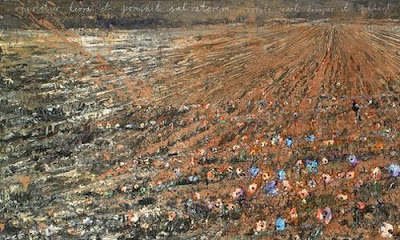
I visited the St. Louis Art Museum at the end of July. The Anselm Kiefer - Burning Rods - stood out as an especially compelling piece. Finished in 1987 - it was made with "oil, acrylic, emulsion, and shellac on canvas with ceramic, iron, copper wire, and lead" - 130 1/4 in. x 18 ft. 3 in.
Seeing that I got to wondering where else there might be paintings of Kiefer's - I noticed that there is a show of his at MASS MoCA through October of 2009. I'm looking forward to going.

From the MASS MOCA site:
German artist Anselm Kiefer conjoins matter, history and time in a moving installation of paintings and monumental sculpture opened October 20, 2007, at MASS MoCA. MASS MoCA’s centerpiece Building 4 galleries feature four vast landscape paintings from a recent series never before seen in the United States, two paintings from the 1980’s, and an immense concrete sculpture, Etroits sont les Vaisseaux.
“Among our most important poets of war, in this surprising body of works Anselm Kiefer presents us with poignant moments of color flowering across the ruined topographies of his vast canvases,” said Joseph Thompson, Director of MASS MoCA. “For reasons I still cannot fully fathom, the Connecticut courts have recently required Andy and Christine Hall to remove Kiefer’s elegiac Etroits sont les Vaisseaux from their property.I’ve long admired that particular sculpture – its siting was exquisite – and I was delighted when the Halls offered it on long-term loan to MASS MoCA. That spirited act of generosity was further amplified as we discussed creating a specific installation of Kiefer works keyed to Etroits sont les Vaisseaux. Admirers of Kiefer will find this exhibition revelatory – the relative profusion of color is unexpected, and somehow especially touching because of that fact – and for those who may have missed the wonderful Fort Worth and Bilbao surveys of Kiefer’s work, this focused installation presents a powerful environment in which to become familiar with his recent work. Two earlier canvases with overlapping themes will place this timely new body of work in a broader context.”
Artforum describes Kiefer’s art as “sensuous and mesmerizing images through which … we gain entry to his arcane mindscape of ancient and recent history, philosophy, botany, Nordic myth, National Socialism, alchemy, and Wagner.” The Independent said in a review of Kiefer’s February 2007 exhibition at London’s White Cubes Gallery: “Great art is about transformation. And transforming experience and transforming materials are what Anselm Kiefer specializes in. The contrasting themes of destruction and recreation, violent upheaval and spiritual renewal, underpin much of the artist's work.”
...Rosenthal describes Kiefer’s paintings: “A landscape by Kiefer always fills the field of the canvas, with the horizon line and suggestion of sky minimal. Adding to this sense of claustrophobia, Kiefer’s typical large-scale format imparts a sense of portentous enormity to the experience. Before one of these mighty paintings, the viewer might feel his face pushed against the painted field, or else envision flying over it, though at a very low altitude. The depicted breadth even conveys a sense of the curvature of the earth. Dark in tonality and sometimes shown with fires burning, these often blackened places seem to have only recently been abandoned by human inhabitants. The depictions are at night or at dusk, thereby adding a melancholic sense of foreboding that horrific events have only just subsided.”
...During the early 1970’s Kiefer studied with conceptual artist Joseph Beuys, whose interest in using an array of cultural myths, metaphors and personal symbolic vocabulary as a means by which to engage and understand history inspired Kiefer.....Kiefer describes his own artistic process as stimulated by Beuys’s philosophies: “Painting, for me, is not just about creating an illusion. I don’t paint to present an image of something. I paint only when I have received an apparition, a shock, when I want to ‘transform’ something. Something that possesses me,and from which I have to deliver myself. Something I need to transform, to metabolize, and which gives me a reason to paint.”

